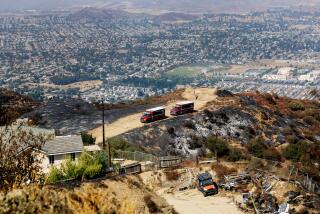Battling Otay Blaze More Like Hand-to-Hand Combat
- Share via
POTRERO, Calif. — In the business of firefighting, the battle against the 14,720-acre blaze on Otay Mountain near the U.S.-Mexico border is being waged with decidedly low-tech weaponry.
Fire crews that bravely battled fires this week in Malibu and La Costa were able to utilize state-of-the-art fire rigs and equipment.
But the remoteness and inaccessibility of the fire on rocky, ravine-rutted Otay Mountain--elevation 3,570 feet--make that approach impossible. For the most part, this fire is being fought the old-fashioned way, by hand, with shovels, axes, saws and picks.
Crews who specialize in what are called “100% wildland fires” in some of the state’s most rugged areas say they would have it no other way.
“Crews that do it say you haven’t fought a fire until you’ve fought a major wildland fire like this: with no rigs, no water, no hydrants, no lines, nothing but the lowest level of equipment,” said California Department of Forestry Capt. Robert Lewin. “It’s just you and the burning brush.”
Or as Charlie Knepp, a firefighter with the U.S. Forest Service, put it: “This is fire at its worst--hot, steep and ugly. If you can fight a fire like this, you can fight anything. I love it.”
Hundreds of firefighters from federal, state and local agencies have been battling the blaze on Otay Mountain near this hamlet, 40 miles east of San Diego, since the first flames were detected shortly after midnight Monday.
Without water, except that which can be dropped by helicopter, the goal is to chop, cut and scrap a break around the wind-driven fire and then let it burn itself out. Luckily, there are no homes or other buildings here, although the fire did destroy two communications towers.
Dave Ortegel, California Department of Forestry division chief, predicts that the fire will not be fully contained until 6 p.m. today. And like other fire commanders throughout Southern California, he is concerned about the specter of dry Santa Ana winds returning.
Besides the remoteness and lack of roads, the Otay Mountain fire has presented several challenges unknown to the week’s other big fires.
One is the suspected presence of illegal immigrants in the fire area. In the wake of Operation Gatekeeper, the Border Patrol crackdown farther to the west, immigrants have increasingly used the paths of Otay Mountain to enter the United States. Fire officials suspect that the current fire is the result of a campfire set by a party of border-crossers.
“We’ve seen the immigrants all throughout the fire area, both this time and in April [1995],” said Ortegel, who was in charge of fighting an April fire on Otay Mountain. “They don’t bother us, we don’t bother them. We’re not the Border Patrol.”
The presence of immigrants has kept firefighters from using what otherwise would be a major tactic in surrounding the fire: lighting backfires to burn toward the blaze and thus halt its march. Ortegel and other Department of Forestry officers have concluded that backfires could prove deadly to immigrants.
The Border Patrol has sent teams to look for possible victims. None has yet been found, but last December five charred skeletons were found, thought to have been immigrants killed in the April fire.
The fire has been fueled in part by the Tecate cypress, a rare tree that environmentalists say lives only on Otay Mountain and Sierra Peak in Orange County.
“The fire gets down in those Tecate cypress and it travels in all directions and then pops out a long way away,” said Allen Hendricks, one of several hundred state prison inmates who have fought the Otay Mountain fire.
Growing to 25 feet or higher, the Tecate cypress not only has leaves that burn fiercely, it also provides a dense canopy under which the fire can travel for miles untouched by water dropped from helicopters.
As of Friday, 750 firefighters were battling the blaze, with a command center set up at the county park in Potrero, a rocky hamlet of 250 people. Twenty-three helicopter landing spots have been cleared in the burned area.
“They’re just grubbing their way around the fire by hand to create a separation between the fire and the combustibles,” said CDF Capt. Mark Bisbee. “It’s very primal.”
More to Read
Sign up for Essential California
The most important California stories and recommendations in your inbox every morning.
You may occasionally receive promotional content from the Los Angeles Times.













